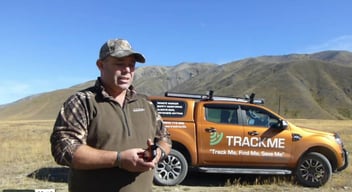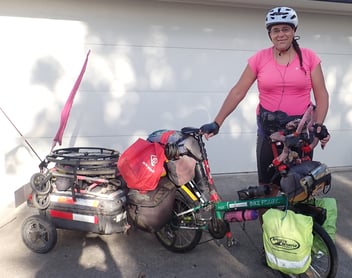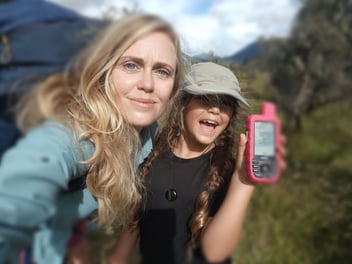The following information is supplied by Tony Glentworth, TrackMe NZ’s owner and founder who is a New Zealand industry expert. The rescue and message features mentioned assume the SMD is working on a satellite plan through TrackMe NZ and not through GARMIN systems in the United States.
TrackMe NZ and I want to encourage people to carry some type of rescue device, be it a satellite messenger device or a PLB, when out in the bush.
Thanks for talking Tony. What is the difference between a personal locator beacon (PLB) and a Satellite Messenger Device (SMD)?
Satellite messenger devices work on independent satellite services. SPOT devices use the Globalstar Network and the GARMIN inReach devices work on the Iridium satellite network. These satellites are circling the globe pole to pole.
PLBs work on COPSAT satellites. These are geostationary, but at a higher elevation than the other satellites.
PLBs are extremely effective devices for getting you found and rescued if you need it. If you have an accident, you set off your PLB, it broadcasts your signal to the COPSAT satellite system. It’s accurate to within 1002 metres. There are a range of satellites in different orbits including geostationary satellites, but it is possible to be in the ‘shadow’ of a mountain, or a building and it may not work immediately.
A PLB has a long battery life as it is used for nothing other than calling in a rescue.
SMDs have an SOS button and get you rescued, but they have more functions. And because of that you do need to be aware of battery usage. The new inReach Mini II has a battery life of around eight days. Even the older devices last three to four days when tracking and people usually top up from a battery pack for longer trips. These GPS units are accurate down to four2 metres.
You can message to cell phone or email via the device, for instance, letting your contact know that you’ve been held up by something, say high river levels, but you’re quite safe, and you’ll be another night; that means they don’t call out a rescue when you don’t make your check-in time.
TrackMe NZ’s 24/7 response centre is available via messages if you are unsure about your situation. If you have a medical event, you can get advice and liaise with medical staff before deciding whether you need rescue; if you become bluffed in the hills, they can help you assess your situation and decide whether a helicopter rescue is the best option.
The devices’ SOS button links directly to the New Zealand Rescue Co-ordination Centre (NZRCC) as well as to TrackMe NZ’s 24/7 response centre. TrackMe NZ’s team will co-ordinate with your contact people and through the unit, with you. You can explain the situation so that the search and rescue (SAR) team know what they are dealing with. This can make a huge difference to the type of response and the outcome for the patient. Being able to explain the situation can also be very reassuring for your contacts, especially if you’ve called in the emergency for someone else’s broken leg.
TrackMe NZ’s system can identify where your device is when you send and receive messages and when using the tracking feature. If, for some reason something happens to you and you’re unable to communicate, TrackMe’s 24/7 response centre know where you were when you stopped moving. More than likely, that’s where you’ll be found.
They do work on different satellite networks though. Should people carry both?
It can never hurt to be prepared and the important thing is to carry something.
People say that they have had messages fail to send, so how can they trust that an SOS message will get through?
Basically, the message function and the SOS are different signals. The Iridium satellites are moving pole to pole. From any part of New Zealand, if you can see one metre of sky above you, then there will be a satellite within range within fifteen minutes. Of course, the more sky you can see, the chance that there’s a communication satellite within range is greater and the quicker a message can be sent. We have successfully sent a message from the bottom of Harwoods Hole. It took five minutes to go out and fifteen to get a reply back. However, yes, sometimes there are satellite outages. These are very rare and usually rectified within an hour. TrackMe NZ have a 99.95% up time.
One of the common mistakes that people make in sending messages is that they close their Earthmate app before the message has successfully sent. The app sends your message to the inReach and expects a ‘sent’ confirmation notification from the device to tell it the message was sent. If you turn the app off before this confirmation comes back, the next time you turn it on it will resend the message. Just leave your phone on and connected to the unit until you get the ping. The battery usage of your phone is minimal while paired to the unit anyway.
Previously TrackMe NZ used a relay to send messages via the GARMIN Enterprise system but now we have a more direct route. We have a far better delivery and reply setup, and customers notice the speed and ease that our Portal creates when they message, not only home, but between devices.
So, why does an SOS from a SMD work better than a message?
An SOS message is a code and not a message as such. It is a smaller packet and therefore easier to relay between satellites. Bigger packeted messages, freeform text messages, can be up to ten times bigger than the SOS code sent out and won’t be sent unless the device gets a confirmation tone back from the closest iridium satellite.
When you send an SOS, it broadcasts on a scatter gun approach and communicates with any Iridium (inReach) or Globalstar (SPOT) satellite it can find, not necessarily the one which gives it a solid confirmation tone back to the device. SOS codes can ‘get out’ without getting a success response back from the satellite, which helps in marginal conditions. Any double-ups are sorted out at the ground station as each message is assigned a unique ID by the receiving process.
Once the SOS has been set off, the device will keep broadcasting that code eleven times in the first ten minutes then every fifteen minutes for the next six hours. After that it will send every hour until the battery is flat. The PLB uses a similar system.
The point is, even if you are really unlucky and there happens to be a satellite outage (0.05%) when you press the SOS, the system will be back up in time to receive the next message out of your device. TrackMe NZ have never had an SOS message fail.





Leave a Comment